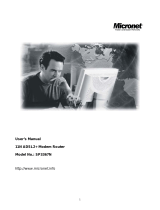
Content
1. Introduction................................................................................................................................................ 3
1.1Features ...........................................................................................................3
1.2 Specification....................................................................................................4
1.3 Package Contents...........................................................................................5
2. Hardware Installation............................................................................................................................. 5
2.1 Product Description.........................................................................................5
2.1.1 Front Panel and LEDs....................................................................6
2.1.2 Rear Panel.....................................................................................6
2.2 Getting Started.................................................................................................7
2.2.1 System Requirement......................................................................7
2.2.2 Before Installation...........................................................................7
2.2.3 Setting Hardware Connection ........................................................8
2.2.4 Configure your computer................................................................9
3. Using Configuration Menu.................................................................................................................. 16
3.1 Setup Method................................................................................................17
3.2 Basic Setup ...................................................................................................20
3.2.1 Setup Router................................................................................20
3.2.2 Global Address.............................................................................22
3.2.3 Wireless .......................................................................................23
3.2.4 Tools:............................................................................................27
3.2.5 Status:..........................................................................................28
3.2.6 DHCP:..........................................................................................29
3.2.7 Log...............................................................................................30
3.2.8 Statistics:......................................................................................31
3.2.9 Printer:..........................................................................................32
3.3 Advanced Setup ............................................................................................56
3.3.1 Virtual Servers..............................................................................56
3.3.2 Filters ...........................................................................................57
3.3.3 IP/URL Block................................................................................58
3.3.4 Special Apps(Special Applications)...............................................59
3.3.5 DMZ Host.....................................................................................60
3.3.6 MAC Clone...................................................................................61
3.3.7 Dynamic DNS...............................................................................61
3.3.8 Proxy DNS ...................................................................................62
3.3.9 Routing.........................................................................................63
3.3.10 SNMP.........................................................................................64
4. Glossary................................................................................................................................................... 65
5. TCP/IP Port List for Internet Service............................................................................................... 70





















